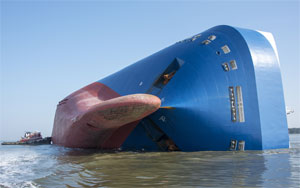Golden Ray left the Port of Brunswick, Ga., early on Sept. 8 with thousands of vehicles packed into its hull. Its journey came to an abrupt end after the ship developed a port-side list and ultimately rolled over in St. Simons Sound within sight of the open ocean.
Nineteen crew and a Brunswick bar pilot escaped the 656-foot ship within hours after it capsized at about 0200 on Sept. 8. Coast Guard air and boat crews coordinated the rescue of the 20 mariners during the overnight hours.
Four engineering crew remained trapped belowdecks for another day and a half, spurring a massive response involving the Coast Guard, salvage experts from Donjon-SMIT, and other partners. The team located the men through hull taps and later opened a hole for them to escape.
Coast Guard Capt. John Reed said the crew who were trapped faced extraordinary conditions, including darkness, extreme heat and lack of food and water. Several were splashed with lubricants during the ordeal.
“Their condition is relatively good for having spent 34 or 35 hours in the conditions they were in,” Reed told reporters just after the first three men were freed. All four of the mariners, believed to be South Korean, received medical treatment at nearby facilities.
The Coast Guard Unified Command reported sheening and oil in nearby marshes in the weeks that followed the incident. The product likely came from “sporadic discharges” from the ship as it lay on its port side. As lightering efforts continued in mid-October, the Unified Command announced that Golden Ray would be disassembled in St. Simons Sound, not refloated, because experts had determined it was not possible to safely right the ship “in a fully intact condition.”
The Marshall Islands-flagged ship departed Brunswick after both discharging and loading vehicles. It had roughly 4,200 vehicles aboard when it left port. The ship prepared to make a starboard turn around Jekyll Island when a stability issue developed, causing a heavy port-side list. The Coast Guard and National Transportation Safety Board (NTSB) are investigating and the cause has not been determined. Another ship was inbound at the time Golden Ray capsized.
 |
|
A Coast Guard MH-65 Dolphin helicopter lands on the side of the capsized ship to drop off supplies for rescuers. |
|
U.S. Coast Guard |
Capt. Jonathan Tennant, the pilot conning Golden Ray when it rolled over, earned praise from the Georgia Ports Authority for his role in intentionally grounding the ship just outside the navigation channel. The move reportedly minimized impacts to the Port of Brunswick.
The Brunswick Bar Pilots Association declined to comment on the incident, citing the ongoing inquiry and the group’s role assisting investigators. Capt. John Cameron, who served as a spokesman for the Brunswick pilots after the incident, said the group is confident the investigation “will show that the pilot’s actions contributed to the best possible outcome.”
“In particular, we’re quite proud of the pilot’s actions to direct tugs and coordinate the immediate rescue while perched on the gyro with a hand-held radio and flashlight,” Cameron said.
Coast Guard boat and helicopter crews were joined in the response by vessels from the South Carolina Department of Natural Resources and Glynn County, Ga. Tugboats from Moran Towing participated in the initial crew rescue that occurred before dawn on Sept. 8. Reed described the effort as “very difficult.”
The rescue “all came together to get 20 people off in the first couple hours, and that was no easy feat in the middle of the night on a vessel laying on its side,” he told NBC News.
Coast Guard crews soon learned the four unaccounted mariners were still on Golden Ray, although it was not known where. Boat crews spent hours on Sept. 8 circling the ship and hitting its hull with a sledgehammer to try and make contact with the men inside, said Coast Guard Petty Officer 1st Class Luke Clayton of Sector Jacksonville.
The tapping process was challenging, he said, because Golden Ray was constantly creaking and cargo was shifting in the hull. On the morning of Sept. 9, “it was still dark, and they were banging on the hull and they were able to get confirmation that someone was banging on the inside,” Clayton said. “That is how they narrowed down their location.”
 |
|
One of the four crewmembers trapped aboard Golden Ray is greeted by Coast Guard personnel and other rescuers after emerging from the ship. |
|
U.S. Coast Guard |
Three of the four crew were in a dry compartment in the engine room, while the fourth was trapped behind glass on another level in an engineering control space. Donjon-SMIT crews opened a 2-by-3-foot hole in the hull, allowing rescue teams to pass food and water to the three crew nearby. They were freed at about 1500 on Sept. 9, tired but not seriously injured.
Donjon-SMIT personnel entered Golden Ray and located the 23rd and final crewmember. They guided him to safety at about 1730 that night after cutting through a glass partition, Clayton said.
The response shifted to pollution control and salvage after the rescue phase ended. Donjon-SMIT divers plugged vents in the ship, and other response personnel laid thousands of feet of containment boom to minimize impacts from leaking fuel. The Unified Command has not yet estimated how much fuel and lubricant oil escaped the ship.
Lightering began in late September and continued into mid-October, when the Unified Command announced that more than 250,000 gallons had been removed from fuel tanks. More than 400 people and 70 vessels were involved in pollution control efforts.
With the investigation still underway, it remains too soon to draw any comparisons between Golden Ray’s capsizing and others involving vehicle carriers. However, the Marine Accident Investigation Branch (MAIB) in the United Kingdom released a report in early 2016 highlighting industrywide stability issues aboard vehicle carriers.
The report, spurred by the capsizing of Hoegh Osaka off the Isle of Wight in January 2015, found the ship rolled to starboard after leaving port with inadequate stability. The ship’s upper decks were loaded with vehicles, while lower decks were “lightly loaded.” The ship also did not take on additional ballast before leaving port in Southampton.
“A key finding of the MAIB investigation is that no departure stability calculation had been carried out on completion of cargo operations and before Hoegh Osaka sailed,” the agency said in its report. “Witness and anecdotal evidence suggests that this practice extends to the car-carrier sector in general.”
Golden Ray, built less than two years before it capsized, can carry about 6,930 cars. It was sailing at less than two-thirds capacity when the incident occurred.

